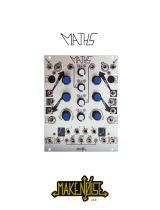
Overview:
FUNCTION is part of the MATHS family of control voltage utility modules. It is a small analog computer
designed for musical purposes. Amongst other things, the Function will allow you to:
1. Generate a variety of linear, logarithmic, or exponential triggered or continuous functions
2. Generate discrete time functions
3. Integrate an incoming signal
4. Invert an incoming signal
5. Generate analog signals from digital information (Gate/ Clock)
6. Generate digital information (Gate/ Clock) from analog signals
7. Delay digital (Gate/ Clock) information
If the above list reads like science rather than music, here is the translation:
1. Voltage Controlled Envelope or LFO
2. Stepped voltages like Sample and Hold, Track and Hold, Staircase LFO
3. Apply Lag, Slew or Portamento to control voltages
4. Modulate backwards!
5. Musical Events such as Ramping up or Down in Tempo, on command
6. Initiating Musical events upon sensing motion in the system
7. Musical note division and/ or Flam
Indeed the FUNCTION is a direct descendent of MATHS, sharing the same core circuit, complete with some
evolutions:
1. Since most Make Noise modules have attenuators on the CV inputs, the scaling/ inversion feature has
been replaced with dedicated Non-Inverted/ Inverted outputs. This is useful as you could have
the same signal modulating two different destinations in opposition.
2. As FUNCTION is single channel design, we included both EOR and EOC. There is interesting things
you could do with these outputs such as flams (see patch tips). Much like CH 1 and 4 on the
MATHS, multiple FUNCTIONs can also be used to program complex functions using EOR and
EOC.
3. The evolution in the circuit is the HANG input. On Gate HIGH at the HANG IN, the FUNCTION is
stopped dead in its tracks. With HANG you can program Stepped LFOs, Synchronized
Functions (using multiple of clock), S&H, Track & Hold, Clock Run/ Stop (using EOR or EOC out
for Clock) and more.
Tips & Tricks
-Longer cycles will be achieved with more Logarithmic response curves. The fastest, sharpest
functions will be achieved with extreme exponential response curves.
-Adjustment to the response curve will affect Rise and Fall Times.
-To achieve longer or shorter Rise and Fall Times than available from Panel Controls, apply a voltage
offset to the Control Signal Inputs.
-Extremely long cycles may be achieved by setting Rise and Fall to about 50% and patching a slow
clock to HANG.
-It helps to have control over the WIDTH of the gate/ clock applied to the HANG input, so another
MATHS (or other modules with Gate/ clock width control such as Pro Modular CLOQ) will be
very handy.
-Use the Inverted Signal OUT where you require reversed modulation but do not have means for
inversion at the CV destination (no attenuvertor).
-Feeding the Inverted Signal OUT back into the FUNCTION at any of the CV inputs is highly useful
(see patch tips).













